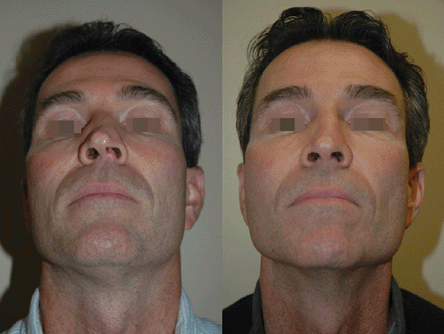Chapter 28. The Twisted Nose
Richard A. Bartlett, MD, FACS
INDICATIONS
The twisted nose is a distinct subclassification of the deviated nose. A deviated nose is uniformly deviated to the right or left like a tilted building. The twisted nose deviates to the right and left in a serpentine manner. Although the deviated nose may be noticeable, the twisted nose often has a bizarre appearance, which can affect self-confidence, social interaction, and even employment opportunities because of the perception of a history of trauma. These factors are the major driver for patients seeking correction.
Virtually all twisted noses have an associated deviated septum and obstructed nasal valves causing nasal airway obstruction. Correction of the twisted nose offers the opportunity to improve the patient’s functional status. Even if the patient is not currently symptomatic, the potential for postoperative obstruction exists if these anatomical deformities are not accounted for.
Correction of the deviated nose should always be considered a combined aesthetic and functional procedure.
PREOPERATIVE PREPARATION
A thorough history should be obtained. The etiology of the twisted nose includes asymmetric growth and development, congenital deformities, such as cleft lip and palate, or facial clefts, trauma, or previous surgery. The underlying cause of the problem will have implications for surgical planning and preparation of the patient. If the patient has a nose that is twisted as a result of asymmetric growth but has had no previous procedures, the surgeon can be reasonably sure that the underlying cartilage framework and septum are intact and will be available for grafting. The unoperated nose will allow an easier dissection, fewer soft-tissue issues because of scar tissue, and a less-complicated postoperative course.
Congenital cleft deformities are often associated with underlying skeletal anomalies, which may require augmentation with grafts or alloplastic materials. The traumatized nose or secondary deformity after surgery is often associated with attenuated cartilages and a septum that may have been harvested, fractured, or affected adversely by hematoma. The most severe example is the patient with a massive septal perforation. Obtaining old operative reports can be helpful, but one should always assume that the septum may be unusable and prepare the patient for the possible harvest of auricular or rib cartilage (Fig. 28-1). This is good practice even if a CT scan indicates that the septum is intact since the actual quality of the cartilage can only be assessed when the specimen is in hand. It is best to discuss all possible donor sites during the preoperative visit.

Figure 28-1 Before and after of a 47-year-old patient with twisted nose and septum. Open dorsal tip split approach with extended spreader grafts from auricular cartilage. Medial and lateral osteotomies.
Examination of the nose follows the general principles for rhinoplasty, including an analysis of the patient’s functional status. Standardized photographs are taken. The use of computer imaging must be carefully considered. Sharing images with the patient is controversial, even in straightforward aesthetic patients, because of the concern that the patient may regard the image as an ironclad guarantee. Most surgeons who utilize computer imaging make it clear to the patient that the images are for planning and discussion but that the actual results may differ. With more complex patients, the chance of the result differing from an idealized image is greater, thereby increasing the chance for unrealistic expectations. Whether computer images are used or not, it is best to emphatically and repeatedly tell the patient that their nose will be “better but not perfect.” The surgeon can choose the best words to communicate this concept, but phrases such as “your nose will be better but still crooked” and “a perfect result is not possible” cannot be repeated too many times.
The standard risks of rhinoplasty are discussed but the patient should be informed that all risks are increased because of the complexity of correcting a twisted nose. It is not necessary to scare the patient, but full disclosure dictates that patients with a twisted nose should know that their situation is unusual and complicated. Families should be informed that the surgery will be longer. All patients should be told that there is an increased risk that a revision may be necessary. To have as much control and exposure as possible, an open technique is used. Patients should be informed that there will be an external scar and should also be prepared for alar base resections.
ANESTHESIA
Stay updated, free articles. Join our Telegram channel

Full access? Get Clinical Tree








